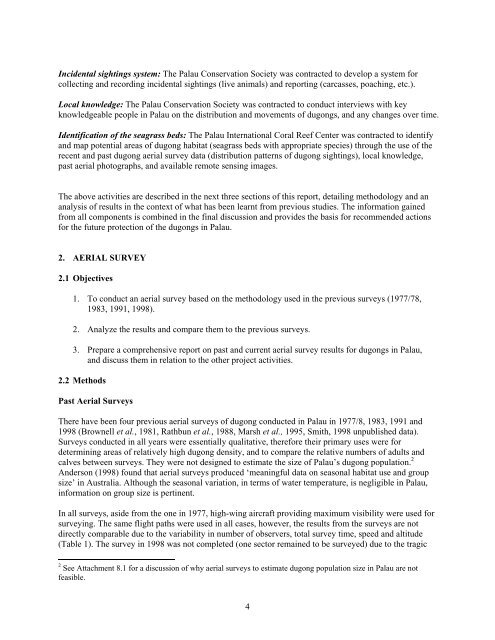dugongs in palau - C3
dugongs in palau - C3
dugongs in palau - C3
Create successful ePaper yourself
Turn your PDF publications into a flip-book with our unique Google optimized e-Paper software.
Incidental sight<strong>in</strong>gs system: The Palau Conservation Society was contracted to develop a system for<br />
collect<strong>in</strong>g and record<strong>in</strong>g <strong>in</strong>cidental sight<strong>in</strong>gs (live animals) and report<strong>in</strong>g (carcasses, poach<strong>in</strong>g, etc.).<br />
Local knowledge: The Palau Conservation Society was contracted to conduct <strong>in</strong>terviews with key<br />
knowledgeable people <strong>in</strong> Palau on the distribution and movements of <strong>dugongs</strong>, and any changes over time.<br />
Identification of the seagrass beds: The Palau International Coral Reef Center was contracted to identify<br />
and map potential areas of dugong habitat (seagrass beds with appropriate species) through the use of the<br />
recent and past dugong aerial survey data (distribution patterns of dugong sight<strong>in</strong>gs), local knowledge,<br />
past aerial photographs, and available remote sens<strong>in</strong>g images.<br />
The above activities are described <strong>in</strong> the next three sections of this report, detail<strong>in</strong>g methodology and an<br />
analysis of results <strong>in</strong> the context of what has been learnt from previous studies. The <strong>in</strong>formation ga<strong>in</strong>ed<br />
from all components is comb<strong>in</strong>ed <strong>in</strong> the f<strong>in</strong>al discussion and provides the basis for recommended actions<br />
for the future protection of the <strong>dugongs</strong> <strong>in</strong> Palau.<br />
2. AERIAL SURVEY<br />
2.1 Objectives<br />
1. To conduct an aerial survey based on the methodology used <strong>in</strong> the previous surveys (1977/78,<br />
1983, 1991, 1998).<br />
2. Analyze the results and compare them to the previous surveys.<br />
3. Prepare a comprehensive report on past and current aerial survey results for <strong>dugongs</strong> <strong>in</strong> Palau,<br />
and discuss them <strong>in</strong> relation to the other project activities.<br />
2.2 Methods<br />
Past Aerial Surveys<br />
There have been four previous aerial surveys of dugong conducted <strong>in</strong> Palau <strong>in</strong> 1977/8, 1983, 1991 and<br />
1998 (Brownell et al., 1981, Rathbun et al., 1988, Marsh et al., 1995, Smith, 1998 unpublished data).<br />
Survey s conducted <strong>in</strong> all years were essentially qualitative, therefore their primary uses were for<br />
determ<strong>in</strong><strong>in</strong>g areas of relatively high dugong density, and to compare the relative numbers of adults and<br />
calv es between surveys. They were not designed to estimate the size of Palau’s dugong population. 2<br />
Anderson (1998) found that aerial surveys produced ‘mean<strong>in</strong>gful data on seasonal habitat use and group<br />
size’ <strong>in</strong> Australia. Although the seasonal variation, <strong>in</strong> terms of water temperature, is negligible <strong>in</strong> Palau,<br />
<strong>in</strong>formation on group size is pert<strong>in</strong>ent.<br />
In all surveys, aside from the one <strong>in</strong> 1977, high-w<strong>in</strong>g aircraft provid<strong>in</strong>g maximum visibility were used for<br />
survey<strong>in</strong>g. The same flight paths were used <strong>in</strong> all cases, however, the results from the surveys are not<br />
directly comparable due to the variability <strong>in</strong> number of observers, total survey time, speed and altitude<br />
(Table 1). The survey <strong>in</strong> 1998 was not completed (one sector rema<strong>in</strong>ed to be surveyed) due to the tragic<br />
2 See Attachment 8.1 for a discussion of why aerial surveys to estimate dugong population size <strong>in</strong> Palau are not<br />
feasible.<br />
4











